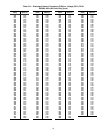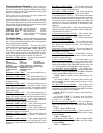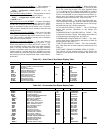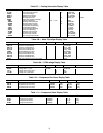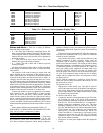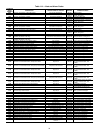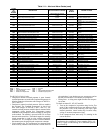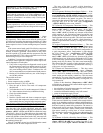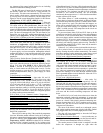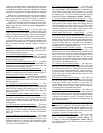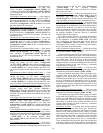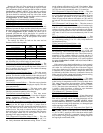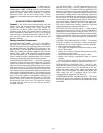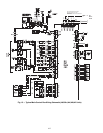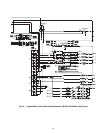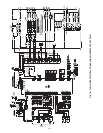
97
any elements of the control which requires its use including
economizer differential enthalpy control.
The RA.RH sensor is located in the return air section near
the auxiliary control box. The sensor is a loop powered 4 to
20 mA sensor. This alert resets automatically. The cause of the
alert is usually a faulty sensor, a shorted or open sensor caused
by a wiring error, or a loose connection. The unit must be con-
figured to use the sensor through the Outside Air RH Sensor
(Configuration
UNIT
SENS
RRH.S) setting.
T082 (Space Temperature Offset Sensor Failure)
— If the unit
is configured to use a space temperature sensor and is using a
T56 sensor with an offset potentiometer, then the alert will
occur if the potentiometer is outside the allowable range. The
control will default to the software applicable set point because
there is no offset available that may be applied to space temper-
ature. The alert will automatically clear. The unit must be con-
figured for one of the SPT control options through the Unit
Control Type (Configuration
UNIT
C.TYP) configuration.
T090 (Circuit A Discharge Pressure Transducer Failure)
T091 (Circuit B Discharge Pressure Transducer Failure) —
Alert codes 090, and 091 are for circuits A and B respectively.
These alerts occur when the unit is configured for pressure
transducers (Configuration
UNIT
DP.XR) and the pres-
sure is outside the range 0.0 to 667.0 psig. A circuit cannot run
when this alert is active. Use the scrolling marquee to reset the
alert. The cause of the alert is usually a faulty transducer, faulty
5v power supply, or a loose connection. Although the software
supports this option, it is not possible at the time of the writing
of this specification to order the optional discharge pressure
transducers.
T092 (Circuit A Suction Pressure Transducer Failure)
T093 (Circuit B Suction Pressure Transducer Failure) — Alert
codes 092, and 093 are for circuits A and B respectively. These
alerts occur when the pressure is outside the following ranges:
0.5 to 134.5 psig when SP.XR=0, 0.0 to 200.0 psig when
SP.XR=1, and 0.0 to 420.0 psig on all 48/50A2,A3,A4,A5
units. A circuit cannot run when this alert is active. Use the
scrolling marquee to reset the alert. The cause of the alert is
usually a faulty transducer, faulty 5 v power supply, or a loose
connection.
T110 (Circuit A Loss of Charge)
T111 (Circuit B Loss of Charge) — Alert codes 110, and 111
are for circuits A, and B respectively. These alerts occur when
the compressor is OFF and the suction pressure is less than
5 psig for 48/50AJ,AK,AW,AY units or 18 psig for 48/50A2,
A3,A4,A5 units and the OAT is above –5 F for 1 continuous
minute. The alert will automatically clear when the suction
pressure transducer reading is valid and greater than 15 psig for
48/50AJ,AK,AW,AY units or 54 psig for 48/50A2,A3,A4,A5
units. The cause of the alert is usually low refrigerant pressure
or a faulty suction pressure transducer.
P120 (Circuit A Low Saturated Suction Temperature —
Compressor A2 Shutdown)
T120 (Circuit A Low Saturated Suction Temperature Alert)
A120 (Circuit A Low Saturated Suction Temperature Alarm)
P121 (Circuit B Low Saturated Suction Temperature —
Compressor B2 Shutdown)
T121 (Circuit B Low Saturated Suction Temperature Alert)
A121 (Circuit B Low Saturated Suction Temperature Alarm)
— This alert/alarm is used to keep the evaporator coils from
freezing and the saturated suction temperature above the low
limit for the compressors.
There will be a start-up delay if the outside-air temperature
is too low. When the outdoor ambient is below 60 F, during ini-
tial start-up, saturated suction temperature will be ignored for a
period of 5 minutes. When Temperatures
REF.T
SSTA or
Temperatures
REF.T
SSTB is less than 20 F for 4 minutes,
less than 10 F for 2 minutes, less than 0° F for 1 minute or less
than –20 F for 20 seconds continuously, the second compressor
of the affected circuit, if it exists, will be shut down with a local
alert (P120, P121) and a 10-minute timeguard will be added to
the compressor. If saturated suction temperature continues to
be less than 20 F for 4 minutes, less than 10 F for 2 minutes,
less than 0° F for 1 minute or less than –20 F for 20 seconds
continuously then compressor no. 1 will be shut down and then
an alert or alarm will be issued.
This failure follows a 3 strike methodology whereby the
first two times a circuit goes down entirely, an alert will be gen-
erated which keeps the circuit off for 15 minutes before allow-
ing the circuit to try again. The third time this happens, an
alarm will be generated which will necessitate a manual reset
to get the circuit back running. It is important to note that a
“strike” is called out only if all compressors in the circuit are
off at the time of alert/alarm.
To prevent nuisance alerts, P120 and P121 show up in the
alarm history and locally at the display but are not broadcast to
the network. To recover from these alerts, a 10-minute holdoff
timer must elapse and the saturated suction temperature must
rise above 29.32 F. If recovery occurs, staging will be allowed
on the circuit again. Again, a “strike” is tied to the circuit going
off entirely, not reducing capacity and recovering. Therefore it
is possible that multiple P120 or P121 alerts may be stored in
alarm history but not broadcast.
If there are 1 or 2 strikes on the circuit and the circuit recov-
ers for a period of time, it is possible to clear out the strikes
thereby resetting the strike counter automatically. The control
must have saturated suction temperature greater than or equal
to 34 F for 60 minutes in order to reset the strike counters.
T122 (Circuit A High Saturated Suction Temperature)
T123 (Circuit B High Saturated Suction Temperature) — Alert
codes 122 and 123 occur when compressors in a circuit have
been running for at least 5 to 30 minutes (Configuration
COOL
H.SST). On 48/50AJ,AK,AW,AY units, this alert
code occurs if the circuit saturated suction temperature is great-
er than 60 F. On 48/50A2,A3,A4,A5 units, this alert code oc-
curs if the circuit saturated suction temperature is greater than
65 F when one compressor is running or 60 F when two com-
pressors are running. For all units, the high saturated suction
alert is generated and the circuit is shut down. Alert code 122 is
for circuit A and 123 for circuit B.
T126 (Circuit A High Head Pressure)
T127 (Circuit B High Head Pressure) — Alert codes 126,
and 127 are for circuits A and B respectively. On 48/
50AJ,AK,AW,AY units, these alerts occur when the appropri-
ate saturated condensing temperature is greater 145 F. Prior to
the alert, the control will shut down one compressor on a circuit
if that circuit's saturated condensing temperature is greater than
140 F. If SCT continues to rise to greater than 145 F, the alert
will occur and the circuit's remaining compressor will shut
down.
On 48/50A2,A3,A4,A5 units, these alerts occur when the
appropriate saturated condensing temperature is greater than
150 F. Prior to the alert, the control will shut down one com-
pressor on a circuit if that circuit's saturated condensing tem-
perature is greater than 145 F. If SCT continues to rise to great-
er than 150 F, the alert will occur and the circuit's remaining
compressor will shut down.
The cause of the alarm is usually an overcharged system,
high outdoor ambient temperature coupled with dirty outdoor
coil, plugged filter drier, or a faulty high-pressure switch.
The alert will clear automatically or when the OAT drops
5° F from the time of the alert.
A140 (Reverse Rotation Detected)
— A test is made once, on
power up, for suction pressure change on the first activated cir-
cuit. The unit control determines failure is as follows:
The suction pressure of both circuits is sampled 5 seconds
before the compressor is brought on, right when the



